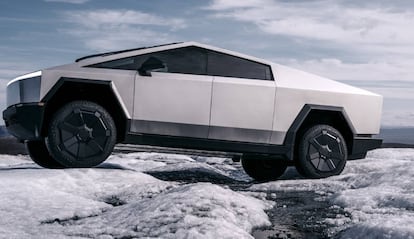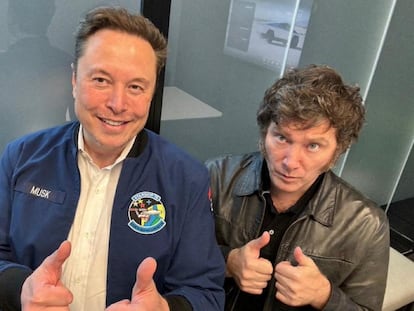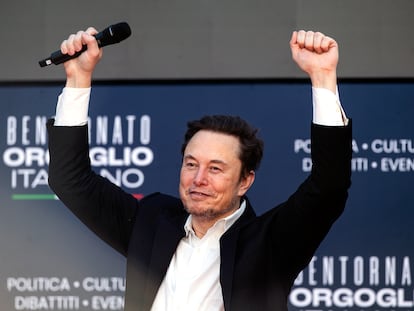From self-driving cars in 2017 to a million robotaxis in 2020: Will the Cybercab be another one of Elon Musk’s unfulfilled promises?
The tycoon has announced that production of the vehicle will begin in 2026; however, he often exaggerates predictions about Tesla’s future achievements, which typically arrive years late or may never materialize at all

Elon Musk on Thursday unveiled Tesla’s robotaxi prototype, the Cybercab — a driverless taxi without a steering wheel or pedals — aimed at revolutionizing urban mobility. True to his style, he used the spotlight to predict when they will be available: “Probably, I tend to be a little optimistic with time frames, but in 2026. So, yeah, before 2027, let me put it that way.” He made this statement despite Tesla not yet having the necessary regulatory approvals to operate such vehicles. Meanwhile, San Francisco has already had a fleet of Waymo robotaxis in operation for some time
Will Musk meet the deadlines he’s set? It wouldn’t be the first time he’s missed a deadline. In fact, the billionaire has a long history of exaggeration when it comes to his much-anticipated project to develop autonomous cars, a technology he sees as the future of the company. “The value of Tesla overwhelmingly is autonomy,” he told investors this summer. This technology is his key strategy to outpace both traditional automakers and Chinese electric vehicle manufacturers, who have gained significant ground in recent years.
If Musk’s promises had been accurate, self-driving Teslas would have been on the road by 2017. But seven years later, they are still not ready. Below are some of Musk’s most notable failed predictions about the arrival of fully autonomous Teslas.
Full autonomy by 2017: In December 2015, Musk first pledged to develop self-driving cars with “full autonomy” by 2017. Nine years later, Teslas still require a driver. While they feature systems capable of taking control of the vehicle, human supervision is always required — the driver must be ready to intervene. This system has been involved in several accidents, some fatal, in both the U.S. and China.
Unsupervised driving by 2016: In June 2016, Musk claimed: “The Model S and Model X at this point can drive autonomously with greater safety than a person, right now.” Yet, eight years later, regulators have still not approved Tesla to market vehicles with autopilot systems that don’t require human oversight.
Driving through cities and self-parking: In 2016, Musk posted a video of a Tesla navigating near the company’s offices, tweeting: “Tesla drives itself (no human input at all) through urban streets to highway to streets, then finds a parking spot.” However, during a 2018 trial related to an accident, Tesla clarified that the video was merely an “aspirational” demonstration of what their cars might eventually achieve.
One million robotaxis by 2020: “I feel very confident predicting autonomous robotaxis for Tesla next year,” Musk said in 2019. They won’t be “in all jurisdictions, because we won’t have regulatory approval everywhere, but I am confident we will have at least regulatory approval somewhere, literally next year,” he added. Musk’s bold prediction came with a specific target: he envisioned deploying a million robotaxis on the streets. Five years later, he has only just unveiled the prototype of this vehicle, which still lacks the necessary permits to operate.
The floating Cybertruck. When Musk unveiled the first prototype of the Cybertruck, Tesla’s electric pickup, in 2019, he claimed it would start at $39,900 and boast a range of around 500 miles. However, today the cheapest version costs at least $60,000 and has a range of just over 300 miles on a single charge.

In addition to its futuristic design, the Cybertruck was promoted with some remarkable features, including “unbreakable” windows — though they were famously shattered during a live demonstration. Even more striking was his claim that the Cybertruck would be able to float for short periods, allowing it to cross rivers. Or so Musk said.
Extending the driving range has long been a major focus for electric car manufacturers, as it’s their key weakness compared to combustion engine vehicles. Musk has been deeply involved in this challenge, stating: “My guess is probably we could break 1,000 kilometers [620 miles] within a year or two. I’d say 2017 for sure.” However, Tesla still hasn’t surpassed 600 kilometers (372 miles) of range.
Other promises
Whether due to arrogance or as part of a marketing strategy, Musk has made a series of unfulfilled promises across various fields:
Twitter will reach 1 billion users. Musk made this claim in November 2022, shortly after acquiring the company. Today, however, the platform remains far from that number.
The app for everything. Musk envisions turning Twitter (now X) into an all-in-one app for shopping, booking tickets, and more. So far, the most notable additions since his takeover have been adult content and a reduction in content moderation.
Solving climate change. “SpaceX is starting a program to take CO2 out of atmosphere & turn it into rocket fuel,” he said in 2021.
Hyperloop in Chicago. In 2018, Musk and the Chicago mayor announced plans to build an 18-mile tunnel connecting downtown to O’Hare Airport, with a hyperloop train completing the trip in 12 minutes. The project — like Musk’s original 2013 hyperloop vision for high-speed travel — has never gotten off the ground.
Human colonies on Mars. In 2014, Musk predicted that humans would land on Mars by 2024 and expressed his desire to build a self-sustaining city on the planet. Neither goal has been realized.
Sign up for our weekly newsletter to get more English-language news coverage from EL PAÍS USA Edition
Tu suscripción se está usando en otro dispositivo
¿Quieres añadir otro usuario a tu suscripción?
Si continúas leyendo en este dispositivo, no se podrá leer en el otro.
FlechaTu suscripción se está usando en otro dispositivo y solo puedes acceder a EL PAÍS desde un dispositivo a la vez.
Si quieres compartir tu cuenta, cambia tu suscripción a la modalidad Premium, así podrás añadir otro usuario. Cada uno accederá con su propia cuenta de email, lo que os permitirá personalizar vuestra experiencia en EL PAÍS.
¿Tienes una suscripción de empresa? Accede aquí para contratar más cuentas.
En el caso de no saber quién está usando tu cuenta, te recomendamos cambiar tu contraseña aquí.
Si decides continuar compartiendo tu cuenta, este mensaje se mostrará en tu dispositivo y en el de la otra persona que está usando tu cuenta de forma indefinida, afectando a tu experiencia de lectura. Puedes consultar aquí los términos y condiciones de la suscripción digital.
More information
Archived In
Últimas noticias
Millennia-old Yuracaré language resists extinction through 900 speakers and a new dictionary
Susan Boyle prepares a comeback just as Timothée Chalamet sings her praises
Trump suspends green card visa lottery after shooting at Brown University
When things get out of hand at the lab: Hundreds of accidents expose the ‘catastrophic’ risk of dangerous pathogen leaks
Most viewed
- Christian Louboutin: ‘Young people don’t want to be like their parents. And if their parents wear sneakers, they’re going to look for something else’
- Cartels in Mexico take a leap forward with narco-drones: ‘It is criminal groups that are leading the innovation race’
- Liset Menéndez de la Prida, neuroscientist: ‘It’s not normal to constantly seek pleasure; it’s important to be bored, to be calm’
- ‘El Limones’ and the growing union disguise of Mexican organized crime
- The low-cost creative revolution: How technology is making art accessible to everyone











































